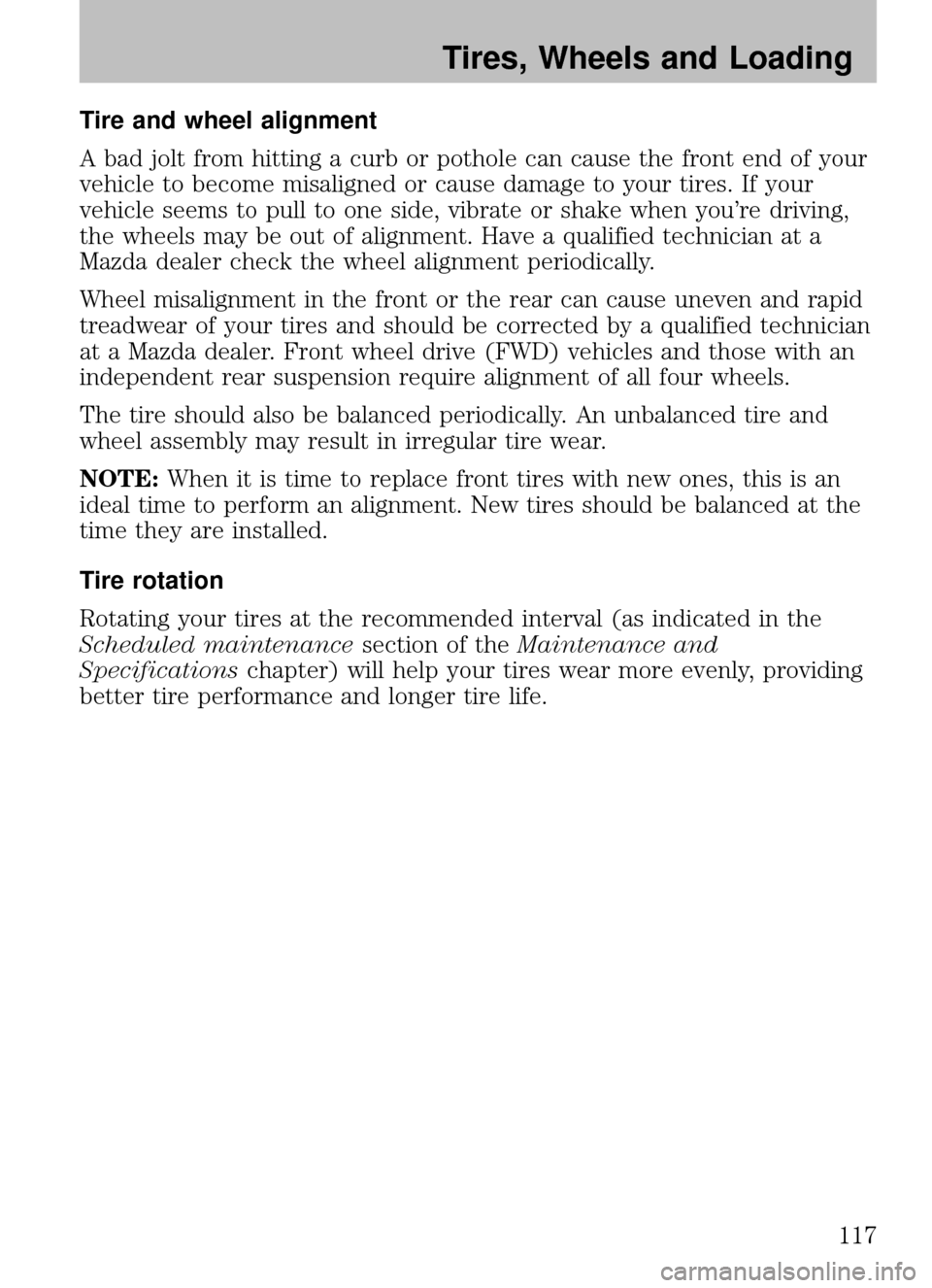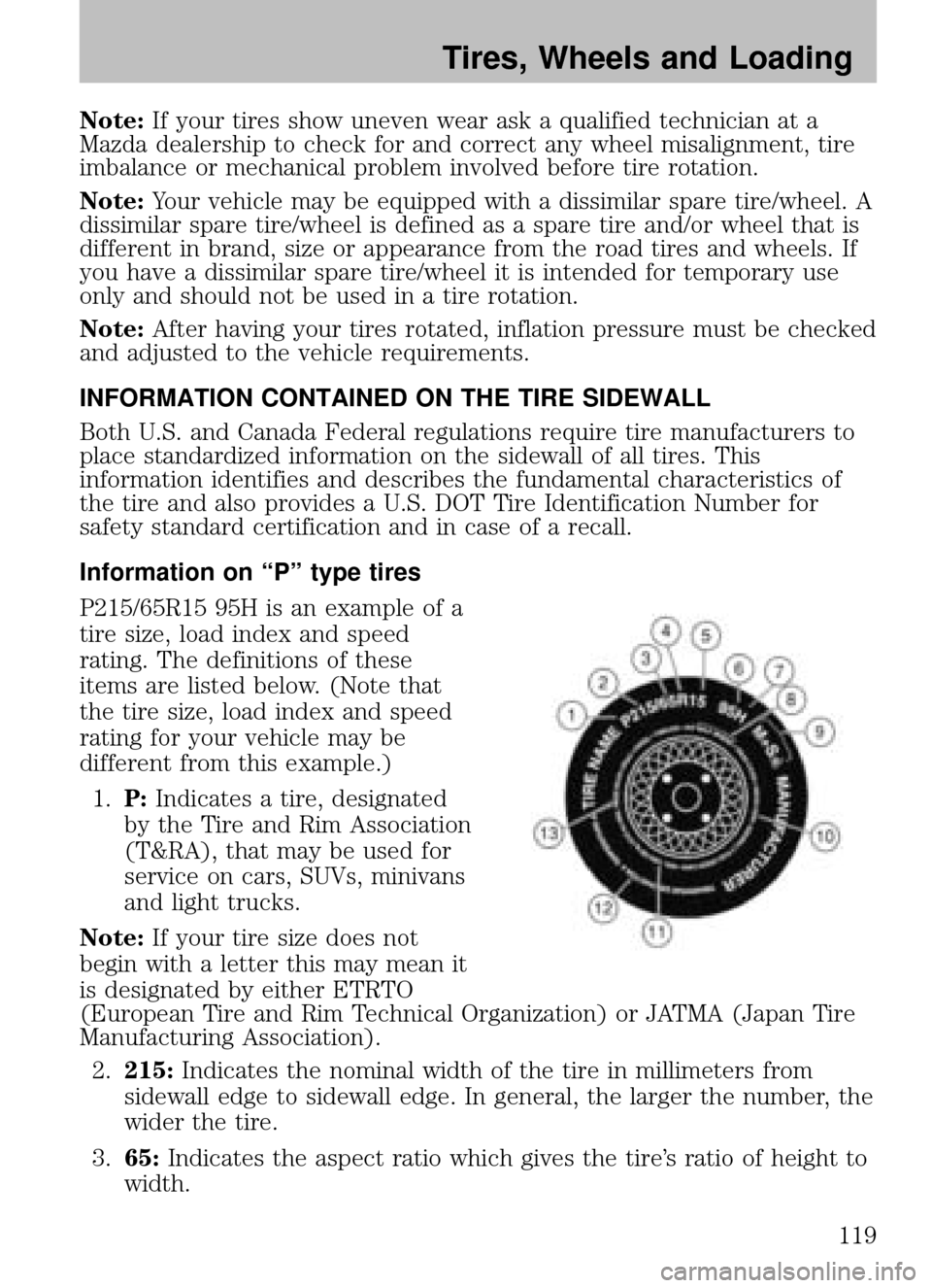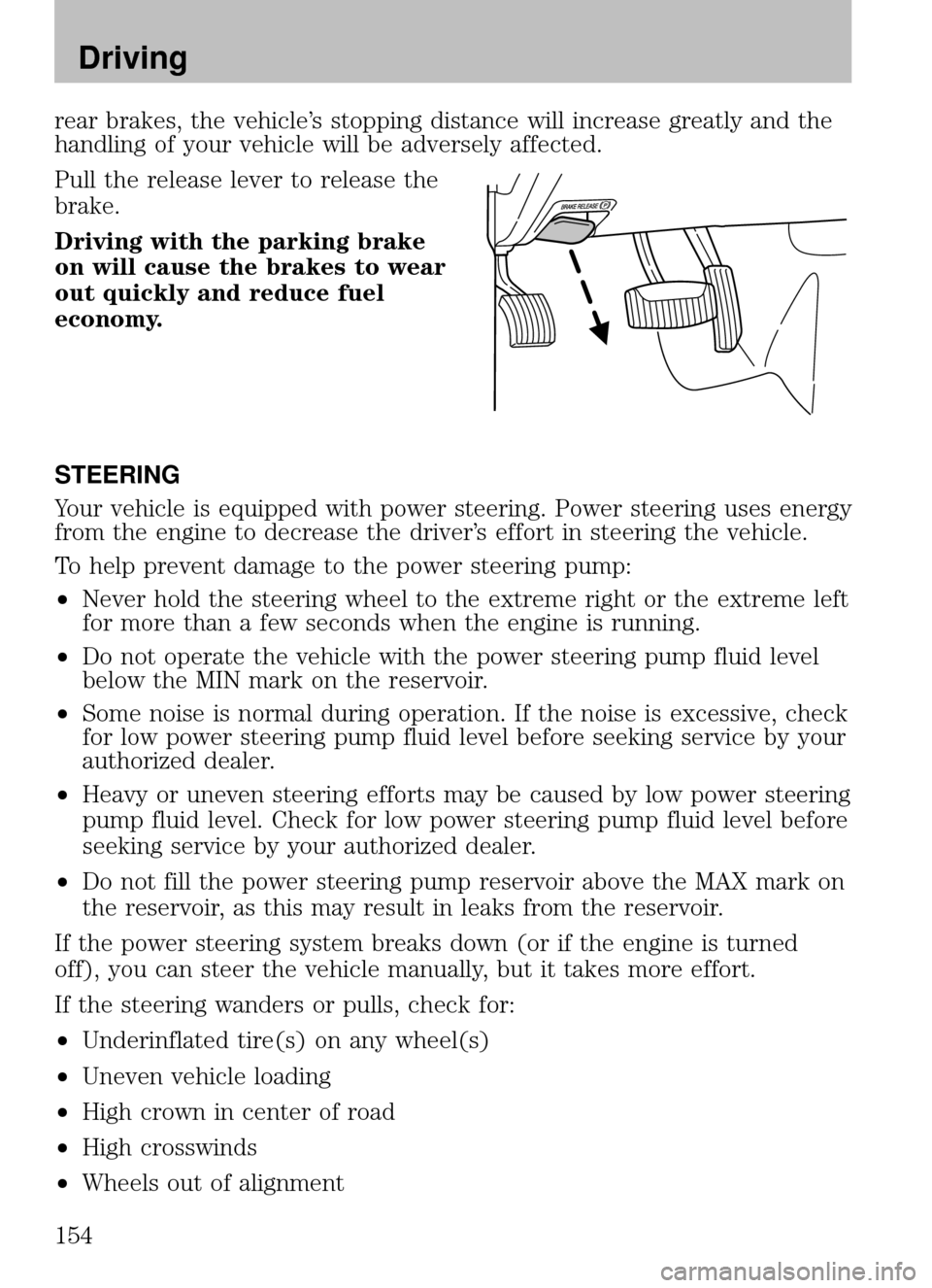2008 MAZDA MODEL B2300 TRUCK wheel alignment
[x] Cancel search: wheel alignmentPage 117 of 280

Tire and wheel alignment
A bad jolt from hitting a curb or pothole can cause the front end of your
vehicle to become misaligned or cause damage to your tires. If your
vehicle seems to pull to one side, vibrate or shake when you’re driving,
the wheels may be out of alignment. Have a qualified technician at a
Mazda dealer check the wheel alignment periodically.
Wheel misalignment in the front or the rear can cause uneven and rapid
treadwear of your tires and should be corrected by a qualified technician
at a Mazda dealer. Front wheel drive (FWD) vehicles and those with an
independent rear suspension require alignment of all four wheels.
The tire should also be balanced periodically. An unbalanced tire and
wheel assembly may result in irregular tire wear.
NOTE:When it is time to replace front tires with new ones, this is an
ideal time to perform an alignment. New tires should be balanced at the
time they are installed.
Tire rotation
Rotating your tires at the recommended interval (as indicated in the
Scheduled maintenance section of theMaintenance and
Specifications chapter) will help your tires wear more evenly, providing
better tire performance and longer tire life.
2008 B-Series (mbs)
Owners Guide (post-2002-fmt)
USA (fus)
Tires, Wheels and Loading
117
Page 119 of 280

Note:If your tires show uneven wear ask a qualified technician at a
Mazda dealership to check for and correct any wheel misalignment, tire
imbalance or mechanical problem involved before tire rotation.
Note: Your vehicle may be equipped with a dissimilar spare tire/wheel. A
dissimilar spare tire/wheel is defined as a spare tire and/or wheel that is
different in brand, size or appearance from the road tires and wheels. If
you have a dissimilar spare tire/wheel it is intended for temporary use
only and should not be used in a tire rotation.
Note: After having your tires rotated, inflation pressure must be checked
and adjusted to the vehicle requirements.
INFORMATION CONTAINED ON THE TIRE SIDEWALL
Both U.S. and Canada Federal regulations require tire manufacturers to
place standardized information on the sidewall of all tires. This
information identifies and describes the fundamental characteristics of
the tire and also provides a U.S. DOT Tire Identification Number for
safety standard certification and in case of a recall.
Information on “P” type tires
P215/65R15 95H is an example of a
tire size, load index and speed
rating. The definitions of these
items are listed below. (Note that
the tire size, load index and speed
rating for your vehicle may be
different from this example.)
1. P:Indicates a tire, designated
by the Tire and Rim Association
(T&RA), that may be used for
service on cars, SUVs, minivans
and light trucks.
Note: If your tire size does not
begin with a letter this may mean it
is designated by either ETRTO
(European Tire and Rim Technical Organization) or JATMA (Japan Tire
Manufacturing Association).
2. 215: Indicates the nominal width of the tire in millimeters from
sidewall edge to sidewall edge. In general, the larger the number, the
wider the tire.
3. 65: Indicates the aspect ratio which gives the tire’s ratio of height to
width.
2008 B-Series (mbs)
Owners Guide (post-2002-fmt)
USA (fus)
Tires, Wheels and Loading
119
Page 154 of 280

rear brakes, the vehicle’s stopping distance will increase greatly and the
handling of your vehicle will be adversely affected.
Pull the release lever to release the
brake.
Driving with the parking brake
on will cause the brakes to wear
out quickly and reduce fuel
economy.
STEERING
Your vehicle is equipped with power steering. Power steering uses energy
from the engine to decrease the driver’s effort in steering the vehicle.
To help prevent damage to the power steering pump:
•Never hold the steering wheel to the extreme right or the extreme left
for more than a few seconds when the engine is running.
• Do not operate the vehicle with the power steering pump fluid level
below the MIN mark on the reservoir.
• Some noise is normal during operation. If the noise is excessive, check
for low power steering pump fluid level before seeking service by your
authorized dealer.
• Heavy or uneven steering efforts may be caused by low power steering
pump fluid level. Check for low power steering pump fluid level before
seeking service by your authorized dealer.
• Do not fill the power steering pump reservoir above the MAX mark on
the reservoir, as this may result in leaks from the reservoir.
If the power steering system breaks down (or if the engine is turned
off), you can steer the vehicle manually, but it takes more effort.
If the steering wanders or pulls, check for:
• Underinflated tire(s) on any wheel(s)
• Uneven vehicle loading
• High crown in center of road
• High crosswinds
• Wheels out of alignment
2008 B-Series (mbs)
Owners Guide (post-2002-fmt)
USA (fus)
Driving
154
Page 248 of 280

•Anticipate stopping; slowing down may eliminate the need to stop.
• Sudden or hard accelerations may reduce fuel economy.
• Slow down gradually.
• Driving at reasonable speeds (traveling at 55 mph [88 km/h] uses 15%
less fuel than traveling at 65 mph [105 km/h]).
• Revving the engine before turning it off may reduce fuel economy.
• Using the air conditioner or defroster may reduce fuel economy.
• You may want to turn off the speed control in hilly terrain if
unnecessary shifting between fourth and fifth gear occurs.
Unnecessary shifting of this type could result in reduced fuel
economy.
• Warming up a vehicle on cold mornings is not required and may
reduce fuel economy.
• Resting your foot on the brake pedal while driving may reduce fuel
economy.
• Combine errands and minimize stop-and-go driving.
Maintenance
• Keep tires properly inflated and use only recommended size.
• Operating a vehicle with the wheels out of alignment will reduce fuel
economy.
• Use recommended engine oil. Refer to the Maintenance product
specifications and capacities section of this chapter.
• Perform all regularly scheduled maintenance items. Follow the
recommended maintenance schedule and owner maintenance checks
found in scheduled maintenance.
Conditions
• Heavily loading a vehicle or towing a trailer may reduce fuel economy
at any speed.
• Carrying unnecessary weight may reduce fuel economy (approximately
1 mpg [0.4 km/L] is lost for every 400 lb [180 kg] of weight carried).
• Adding certain accessories to your vehicle (for example bug
deflectors, rollbars/light bars, running boards, ski/luggage racks) may
reduce fuel economy.
• Using fuel blended with alcohol may lower fuel economy.
• Fuel economy may decrease with lower temperatures during the first
8–10 miles (12–16 km) of driving.
2008 B-Series (mbs)
Owners Guide (post-2002-fmt)
USA (fus)
Maintenance and Specifications
248
Page 273 of 280

Spark plugs, specifications .......264
Special noticeambulance conversions ..............7
utility-type vehicles ....................7
Specification chart,
lubricants ...................................260
Speed control ..............................57
Starting your
vehicle ........................146–147, 149 jump starting ..........................189
Steering wheel tilting .........................................54
T
Tether anchors ..........................102
Tilt steering wheel ......................54
Tire Pressure Monitoring
System (TPMS) Roadside Emergencies ...........179
Tires, Wheels and Loading ....124
Tires ...........................108–109, 179 alignment ................................117
care ..........................................113
changing ..........................179, 184
checking the pressure ............113
inflating ...................................110
label .........................................123
replacing ..................................114
rotating ....................................117
safety practices .......................116
sidewall information ...............119
snow tires and chains ............129
spare tire .................................180
terminology .............................110
tire grades ...............................109
treadwear ........................109, 113
Towing .......................................135 recreational towing .................144
trailer towing ..........................135
wrecker ....................................195
Traction-lok rear axle ...............155
Transfer case fluid checking .........................257
Transmission automatic operation ...............156
brake-shift interlock (BSI) ....156
fluid, checking and adding
(manual) .................................256
lubricant specifications ..........260
manual operation ....................159
Turn signal ..................................46
V
Vehicle Identification Number
(VIN) ..........................................266
Vehicle loading ..........................129 camper bodies ........................145
Ventilating your vehicle ...........149
W
Warning chimes ...........................17
Warning lights (see Lights) .......12
Washer fluid ..............................226
Water, Driving through .............167
Windows power .........................................55
Windshield washer fluid and
wipers ..........................................53 checking and adding fluid .....226
checking and cleaning ............226
replacing wiper blades ...........227
Wrecker towing .........................195
2008 B-Series (mbs)
Owners Guide (post-2002-fmt)
USA (fus)
Index
273